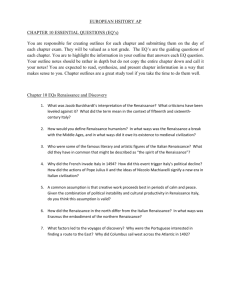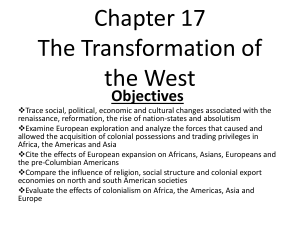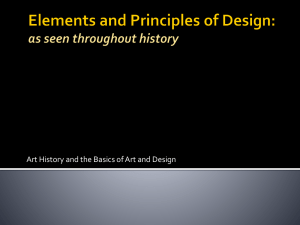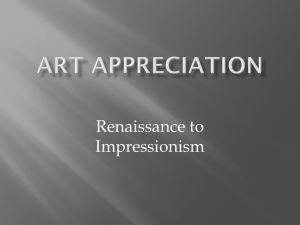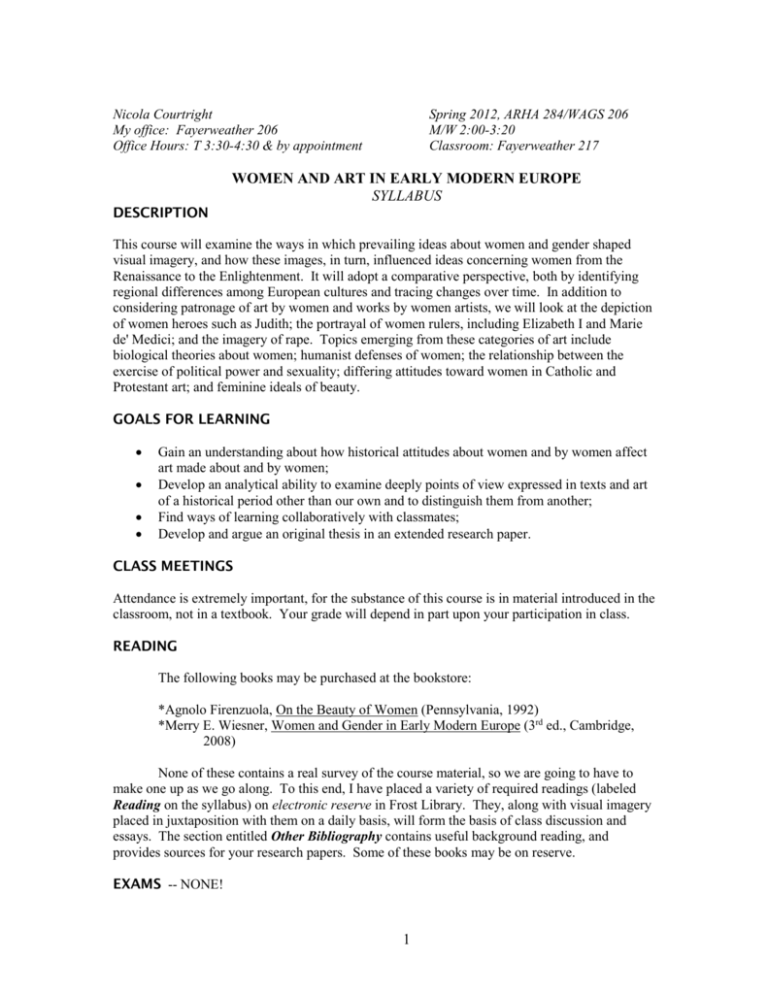
Nicola Courtright
My office: Fayerweather 206
Office Hours: T 3:30-4:30 & by appointment
Spring 2012, ARHA 284/WAGS 206
M/W 2:00-3:20
Classroom: Fayerweather 217
WOMEN AND ART IN EARLY MODERN EUROPE
SYLLABUS
DESCRIPTION
This course will examine the ways in which prevailing ideas about women and gender shaped
visual imagery, and how these images, in turn, influenced ideas concerning women from the
Renaissance to the Enlightenment. It will adopt a comparative perspective, both by identifying
regional differences among European cultures and tracing changes over time. In addition to
considering patronage of art by women and works by women artists, we will look at the depiction
of women heroes such as Judith; the portrayal of women rulers, including Elizabeth I and Marie
de' Medici; and the imagery of rape. Topics emerging from these categories of art include
biological theories about women; humanist defenses of women; the relationship between the
exercise of political power and sexuality; differing attitudes toward women in Catholic and
Protestant art; and feminine ideals of beauty.
GOALS FOR LEARNING
Gain an understanding about how historical attitudes about women and by women affect
art made about and by women;
Develop an analytical ability to examine deeply points of view expressed in texts and art
of a historical period other than our own and to distinguish them from another;
Find ways of learning collaboratively with classmates;
Develop and argue an original thesis in an extended research paper.
CLASS MEETINGS
Attendance is extremely important, for the substance of this course is in material introduced in the
classroom, not in a textbook. Your grade will depend in part upon your participation in class.
READING
The following books may be purchased at the bookstore:
*Agnolo Firenzuola, On the Beauty of Women (Pennsylvania, 1992)
*Merry E. Wiesner, Women and Gender in Early Modern Europe (3rd ed., Cambridge,
2008)
None of these contains a real survey of the course material, so we are going to have to
make one up as we go along. To this end, I have placed a variety of required readings (labeled
Reading on the syllabus) on electronic reserve in Frost Library. They, along with visual imagery
placed in juxtaposition with them on a daily basis, will form the basis of class discussion and
essays. The section entitled Other Bibliography contains useful background reading, and
provides sources for your research papers. Some of these books may be on reserve.
EXAMS -- NONE!
1
COURSE FORMAT AND ASSIGNMENTS
In the first half of the semester you will be developing critical skills through discussion and
analysis of texts and art. (All assignments and course documents will be posted on our web
portals under “My Amherst,” then “Women and Art in Early Modern Europe.”)
The assignments that will help you achieve this goal are:
*Responses and abstracts. Either brief visual analyses of works of art, responses to a prompt
about issues in the readings, or an abstract of the readings will be due before class for posting on
the CMS or Moodle. Your overall grade goes down if you do not post each one. We will discuss
issues emerging from them in class.
*Short, graded papers. Two analyses relate a work of art to a particular issue emerging from the
readings and discussion. I would like you show all first drafts to someone at the Writing Center.
(3 typed pp., one due Week 3 and the other Week 7.) All papers must be typed and submitted
on time online.
Week 3 --First graded analysis (due Friday Feb. 10)
Through observation of elements of form, write about a work of art in the Mead Art Museum
representing a female saint or another woman in a religious context and consider how the artist
conveys an idea about women and spirituality through the use of forms. (See “Considerations for
a Formal Analysis.”) Be sure to:
Organize your paper so that it follows a continuous argument;
Use visual evidence to make your points;
Write at least 2 versions. I recommend you take the first to the Writing Center.
In the second half of the semester you will research and write a paper featuring an original
idea (around 10 pp.) The week-by-week assignments will help you to identify an original idea,
do research on your topic, and develop an argument through sequential writing assignments. You
will still have regular responses to the readings.
Week 5: I’ll be gone Wed., Feb. 22.
Week 6 (Feb. 27-29)
Read Diane Owen Hughes, "Sumptuary Law and Social Relations in Renaissance Italy," or
Christiane Klapisch-Zuber, "The Griselda Complex: Dowry and Marriage Gifts in the
Quattrocento," and analyze the way either writer sets up and makes an argument. In a
few sentences, write:
1) What does the author do in the first paragraph and in the second paragraph? Where does
she say what other scholars have done and what she is preparing to do?
2) What is some of the main evidence she uses to make her point?
3) What is her conclusion? Where does she place it?
Week 7 (March 5-7)
1) Pick a work of art for your research paper and begin your research (see “First Set of
Steps toward a Research Paper”). Hand in paper telling me which work of art you’ve
chosen.
2
2) Second graded analysis (due Friday, March 16)
Through observation of elements of form, write about a work of art in the Mead Art Museum
representing a woman – portrait, domestic scene, or other – and consider how the artist conveys
an idea about women and her place in society through the use of forms. (See “Considerations for
a Formal Analysis.”) Be sure to:
Organize your paper so that it follows a continuous argument;
Use visual evidence to make your points;
Write at least 2 versions. I suggest that you take the first to the Writing Center.
SPRING BREAK – Get plenty of rest and go see some art!
Week 9 (March 26-28) Write and hand in:
1) a page summarizing the usefulness of 3 articles and/or books you’ve located for your research
(“First Set of Steps…”); and
2) a page analyzing the best article on the subject of your research paper in the same manner you
did for the article by Hughes or Klapisch-Zuber (see above, Week 6).
Week 9 (March 31-April 2)
--Collect a group of related works of art and write a paragraph on their similarities and
differences (see “Second Set of Steps toward a Research Paper.”)
Week 10 (April 2-4)
-- Figure out a problem that your topic presents and hand in a paper stating what it is, and positing
a hypothesis for a solution (see “Third Set of Steps toward a Research Paper.”)
--Hand in an annotated bibliography.
--Come see Prof. Courtright with illustrations and talk about your problem/hypothesis.
Week 11 (April 9-11)
--First version of research paper due Wed. April 18 (see “Fourth Set of Steps toward a Research
Paper.”)
1) Write your rough draft.
2) Write a descriptive outline (see “Descriptive Outlines as a Tool for Revision.”)
3) Revise your draft.
Week 12 (April 21-23)
-- Meet with me to discuss your revised first version of your paper.
--Do more research and re-write (see “Fifth Set of Steps toward a Research Paper.”)
-- Go to Writing Center, re-write again.
Week 13. (April 28-30)
-- Final version of research paper due Friday, May 4.
3
TOPICS
Week 1-2 (1-23-2/1)
1. FIRST PRINCIPLES
Art as documentary evidence
Art history and feminism
Biology as destiny
Gender, sexuality
Reading
Primary sources
(1/30)
*Aristotle, De generatione animalium, Bk. 1. ch. 2. (716a-b), trans. D.M. Balme (NY: Oxford
UP, 1992), 21-24, 127-34
Secondary material
1/25
*Scott, Joan W. “Women’s History” and “Gender: A Useful Category of Historical Analysis,”
chaps. 1-2 in her Gender and the Politics of History (rev. ed., NY: Columbia UP, 1999),
17-50; 223-235.
*Delphy, Christine. “Rethinking Sex and Gender,” Feminist Theory Reader: Local and Global
Perspectives, ed. Carole McCann and Seung-Kyung Kim (2nd ed., ), 58-68.
*Wiesner, M. Women and Gender in Early Modern Europe, “Introduction.”
1/30
*MacLean, Ian. The Renaissance Notion of Woman (Cambridge, 1980), Chap. 3, 28-46.
*Greenblatt, Stephen. “Fiction and Friction,” in Reconstructing Individualism: Autonomy,
Individuality,
and the Self in Western Thought, ed. Thomas C. Heller et al. (Stanford: Stanford UP,
1986), 30-52, 329-32
Other Bibliography
Ariès, Philippe, ed. A History of Sexuality, trans. Anthony Forster (Oxford: Blackwell, 1985)
Crawford, Katherine. European Sexualities, 1400-1800 (Cambridge: Cambridge U, 2007)
Davis, Natalie Zemon and Arlette Farge, eds. Renaissance and Enlightenment Paradoxes (A
History of
Women in the West, vol. 3) (Cambridge: Harvard, 1997)
Gilman, Sander. Sexuality: an Illustrated History (New York, 1989).
Hartman, Joan E. and Adele Seeff, eds. Structures and Subjectivities: Attending to Early Modern
Women
(Newark: U Delaware Press, 2007)
Laqueur, Thomas. Making Sex: Body and Gender from the Greeks to Freud (Cambridge, 1990)
Meade, Teresa A. and Merry Wiesner-Hanks, A Companion to Gender History (Malden, MA:
Blackwell,
2004
Muir, Edward and Guido Ruggiero, eds. Sex and Gender in Historical Perspective (Baltimore,
1990)
Simons, Patricia, Gender and Sexuality in Renaissance and Baroque Italy: A Working
4
Bibliography (Sydney, 1988)
Rabb, T.K. and Jonathan Brown. "Introduction," in The Evidence of Art: Images and Meaning in
History, ed. Robert I. Rotberg and T.K. Rabb (Cambridge, 1988), 1-6
Tuana, Nancy. The Less Noble Sex: Scientific, Religious, and Philosophical Conceptions of
Woman's Nature (Indiana, 1993)
Turner, James G., ed. Sexuality and Gender in Early Modern Europe: Institutions, Texts, Images
Cambridge, 1993).
Week 2-3 (1/30-2/8)
2. WOMEN AND CHRISTIANITY: THE MEDIEVAL HERITAGE AND ITS
TRANSFORMATION
Eve
Mary, mother and virgin
Early Christian saints: Mary Magdalene -- Donatello, Caravaggio, Lanfranco
Nuns and mystical union with Christ -- Bernini, Lanfranco
Reading
Primary sources
*Genesis 1, 2
*Teresa of Avila, in Irving Lavin, Bernini and the Unity of the Visual Arts (Oxford, 1981), 107
Secondary material
*Bynum, Caroline Walker. “The Female Body and Religious Practice in the Later Middle Ages,”
in: Fragmentation and Redemption: Essay on Gender and the Human Body in Medieval
Religion
(NY: Zone Books, 1991), 181-238, notes ??
*Miles, Margaret. Image as Insight (Boston: Beacon Press, 1985), Intro., 1-13
*Wiesner, Mary. Women and Gender in Early Modern Europe, Ch. 6
Other Bibliography
Bell, Rudolph M. and Donald Weinstein, Saints and Society: The Two Worlds of Western
Christendom, 1000-1700 (Chicago, 1982)
[Bokenham, Osbern.] A Legend of Holy Women, trans. Sheila Delany (Notre Dame, 1992).
Brown, Peter. The Body and Society: Men, Women and Sexual Renunciation in Early
Christianity (Columbia, 1988)
Bynum, Caroline Walker. Fragmentation and Redemption: Essay on Gender and the Human
Body in Medieval Religion (NY: Zone Books, 1991)
Bynum, Caroline Walker. Holy Feast and Holy Fast: The Religious Significance of Food to
Medieval Women (Berkeley: U Cal Press, 1987)
Johnson, Penelope. Equal in Monastic Profession. Chicago, 1991.
Malvern, Marjorie. Venus in Sackcloth: The Magdalen's Origins and Metamorphoses
(Carbondale and Edwardsville, IL, 1975)
Matter, E. Ann. "The Personal and the Paradigm: The Book of Maria Domitilla Galluzzi," in
The Crannied Wall: Women, Religion, and the Arts in Early Modern Europe, ed. Craig
Monson (U. Michigan, 1992), 87-103
McLaughlin, Megan. "Gender Paradox and the Otherness of God," Gender and History, 31
(1991), 147-59
Miles, Margaret. Carnal Knowing: Female Nakedness and Religious Meaning in the Christian
West
5
(Boston: Beacon Press, 1989)
Or Mooney, Catherine, ed. Gendered Voices: Medieval Saints and their Interpreters (Phil: U
Penn, 1999).
Russell, H. Diane. Eva/Ave: Woman in Renaissance and Baroque Prints (Washington: Nat.
Gallery of Art, 1990)
Schulenberg, Jane Tibbetts. "Female Sanctity: Public and Private Roles, ca. 500-1100," in
Women and Power in the Middle Ages (Athens: U. Georgia, 1988), 102-25
Valone, Carolyn. "Roman Matrons as Patrons: Various Views of the Cloister Wall," in The
Crannied Wall: Women, Religion, and the Arts in Early Modern Europe, ed. Craig
Monson (U. Michigan, 1992), 49-72
Warner, Marina. Alone of All Her Sex: The Myth and Cult of the Virgin Mary (NY: Vintage,
Random House, 1983)
Week 4 (2/13-2/15)
3. THE POWER OF WOMEN
Sexual inversion
Witches
Female heroes
Reading
Primary sources
(2/15)
*Boccaccio, De mulieribus claris/Famous Women, trans. Virginia Brown (Cambridge: Harvard
UP, 1991), 3-7 (Dedication), 159-63 (Penelope), 167-81 (Dido), 193-5 (Sappho), 23343 (Artemisia), 361-73 (Cleopatra), 467-73 (Joanna, queen)
Secondary material
(2/13)
*Monter, William. "Protestant Wives, Catholic Saints, and the Devil's Handmaid: Women in the
Age of Reformations," in Becoming Visible, ed. R. Bridenthal et al. (Boston: Houghton,
1987), 203-219
(2/15)
*Garrard, Artemisia Gentileschi: The Image of the Female Hero in Italian Baroque Art
(Princeton:
Princeton UP, 1989), Chap. 2: "Historical Feminism and Female Iconography," 141-179
*Wiesner, Women and Gender, Ch. 7
Other Bibliography
Buettner, Brigitte. Boccaccio’s Des cleres et nobles femmes : Systems of Signification in an
Illuminated
Manuscript (Seattle: U Wash P, 1996)
Burns, Norman T. and Christopher J. Reagan, eds., Concepts of the Hero in the Middle Ages and
the Renaissance (Albany, 1975)
Cohn, Samuel K., Jr. Women in the Streets: Essays on Sex and Power in Renaissance Italy
(Baltimore, 1996)
Hults, Linda. The Witch as Muse: Art, Gender and Power in Early Modern Europe (Phil: U
Penn P, 2005)
Jordan, Constance. "Boccaccio's In-Famous Women: Gender and Civic Virtue in the De
6
Mulieribus Clarism, in Ambiguous Realities: Women in the Middle Ages and
Renaissance, ed. Carole Levin and Jeanie Watson (Detroit: Wayne State U., 1987),
25-47
Mullins, Edwin B. The Painted Witch: How Western Artists Have Viewed the Sexuality of
Women (New York, 1985)
Smith, Susan L. The Power of Women: A Topos in Medieval Art and Literature (Philadelphia,
1995).
Week 5-6 (2/20-2/29)
4. BEAUTY AND EROTICISM: PORTRAITURE, NUDES
Portraits and proportion
Renaissance vs. Baroque nude
Eroticism
Reading
Primary sources
*Agnolo Firenzuola, On the Beauty of Women (1548) (Philadelphia: U Penn Press, 1992)
*Sigmund Freud [handouts]
Secondary material
*Elizabeth Cropper, "The Beauty of Woman: Problems in the Rhetoric of Renaissance
Portraiture," in Rewriting the Renaissance, ed. M.W. Ferguson et al. (Chicago, 1986),
175-190
*Jones, Ann R. and Peter Stallybrass. Renaissance Clothing and the Material of Memory
(Cambridge: Cambridge UP, 2000), ch. 2 “Composing the Subject: Making Portraits,”
34-58
*Sohm, Philip. “Gendered Style in Italian Art Criticism from Michelangelo to Malvasia.”
Renaissance Quarterly 48 (1995), 759-808.
Other Bibliography
Clark, Kenneth. The Nude: A Study in Ideal Form (NY: Doubleday, 1956)
Duby, Georges, ed. Power and Beauty: Images of Women in Art (London, 1992)
Crawford, Katherine. The Sexual Culture of the French Renaissance (Cambridge and New York:
Cambridge UP, 2010)
Rogers, Mary. "The Decorum of Women's Beauty: Trissino, Firenzuola, Luigini and the
Representation of Women in Sixteenth-Century Painting," Oxford Art Journal, 2 (1988):
47-87
Rosenthal, Margaret F. The Honest Courtesan: Veronica Franco, Citizen and Writer in SixteenthCentury Venice. Chicago, 1992
Saunders, Gill. The Nude: A New Perspective (London: Harper and Row, 1989)
Talvacchia, Bette. Taking Positions: On the Erotic in Renaissance Culture (Princeton: Princeton
UP, 1999)
Wolfthal, Diane. In and Out the Marital Bed. Seeing Sex in Renaissance Europe (New Haven and
London: Yale University Press, 2010
Week 7-9 (3/5-3/28)
5. EARLY MODERN WOMEN: PUBLIC AND PRIVATE IN ITALY
7
Status of women in early modern societies
Italian Renaissance portraits, single and conjugal
Court lady, court imagery in Italy
Reading
Primary material
(3/5)
*Christine de Pisan. A Medieval Woman’s Mirror of Honor: The Treasury of the City of Ladies,
trans. Charity Willard (Tenafly: Persea/Bard Press, 1989), Bk. 1, ch.18-22 (pp. 113-21),
Bk. 2, ch. 10-13 (pp. 170-83), Bk. 3, ch. 1-9 (pp. 185-214)
(3/26)
*Castiglione, The Book of the Courtier, Book 3, trans. Charles Singleton (Doubleday, 1959),
201-82
*Isabella d'Este, selected letters, from Julia Cartwright, Isabella d’Este (London, 1903)
[Courtright will distribute]
Secondary sources
(3/5)
*Wiesner, Women and Gender, Ch. 1-4
*Davis, Natalie Z. Society and Culture in Early Modern France (Stanford, 1975), “Women on
Top,” 124-151
*Hughes, Diane Owen. "Sumptuary Law and Social Relations in Renaissance Italy," in Disputes
and Settlements, ed. John Bossy (Cambridge, 1983), 69-99
*Klapisch-Zuber, Christiane. "The Griselda Complex: Dowry and Marriage Gifts in the
Quattrocento," in her Women, Family, and Ritual in Renaissance Italy, trans. Lydia
Cochrane (Chicago, 1985), 213-47.
(3/26)
*Jordan, Constance. "Feminism and the Humanists: The Case for Sir Thomas Elyot's Defense of
Good Women," in Rewriting the Renaissance, ed. M.W. Ferguson et al. (Chicago, 1986),
242-58
*Solum, Stefanie. “Attributing Influence: the Problem of Female Patronage in Fifteenth-Century
Florence,” The Art Bulletin, 90 (2008), 76-100.
Other Bibliography
WOMEN’S PLACE IN EARLY MODERN SOCIETY
Burckhardt, Jakob. The Civilization of the Renaissance in Italy (Oxford, 1937)
Cereta, Laura. Collected Letters of the Renaissance Feminist, trans. and ed. by Diana Robin
(Chicago, U
Chicago P, 1997)
Goffen, Rona. Titian's Women (New Haven: Yale, 1997)
Kelly, Joan. "Early Feminist Theory and the Querelle des Femmes, 1400-1789," in her Women,
History, and Theory (Chicago, 1984), 65-109
Kelly, Joan. "Did Women Have a Renaissance?," in Becoming Visible, ed. R. Bridenthal et al.
(Boston: Houghton, 1987), 175-201
Kelso, Ruth, Doctrine for the Lady of the Renaissance (Urbana: U. Ill., 1956)
Migiel, Marilyn and Juliana Schiesari, eds., Refiguring Women: Perspectives on Gender and the
Italian Renaissance (Ithaca: Cornell UP, 1991)
Schurman, Anna Maria von. Whether a Christian Woman Should Be Educated and Other
Writings from her Intellectual Circle, ed. Joyce L. Irwin (Chicago, 1998)
Simons, Patricia. "(Check)mating the Grand Masters: The Gendered Sexualized Politics of
Chess in Renaissance Italy," Oxford Art Journal 16 (1993): 59-74
8
Tinagli, Paola. Women in Italian Renaissance Art: Gender, Representation, Identity (Manchester
and NY, 1997)
Wiesner, Merry. "Women's Defense of Their Public Role," in Women in the Middle Ages and the
Renaissance, ed. M.B. Rose (Syracuse, 1986), 1-27
FAMILY
Alberti, Leon Battista. Della famiglia/The Family in Renaissance Florence, trans. R. Watkins
(Columbia: U. So. Carolina P, 1969)
Ariès, Philippe. Centuries of Childhood: A Social History of Family Life (NY: Vintage, 1962)
Ariès, P. and Georges Duby, eds. A History of Private Life, 5 vols. (Cambridge: Harvard, 1987)
Goody, Jack. The Development of the Family and Marriage in Europe (Cambr: Cambridge UP,
1983)
Ozment, Steven. When Fathers Ruled: Family Life in Reformation Europe (Cambridge: Harvard,
1983)
MARRIAGE
Barbaro, Francesco. "On Wifely Duties," in The Earthly Republic: Italian Humanists on
Government and Society, ed. B. Kohl and R.G. Witt, (Philadelphia, U.Penn Press, 1978)
177-228
Baskins, Cristelle. Cassone Painting, Humanism and Gender in Early Modern Italy (Cambridge:
Cambridge UP, 1998)
Benson, Pamela Joseph. The Invention of the Renaissance Woman (Penn State U., 1992)
Bestor, Jane Fair. “Marriage Transactions in Renaissance Italy and Mauss’s Essay on the Gift,”
Past and Present 164 (Aug., 1999), 6-46
Christiansen, Keith. "Lorenzo Lotto and the Tradition of Epithalamic Paintings," Apollo, 124,
1986, 166-73
Duby, Georges. Love and Marriage in the Middle Ages (Chicago, 1994)
Hughes, Diane Owen. “From Brideprice to Dowry in Mediterranean Europe,” Journal of Family
History 3, 3 (1978), 262-96
King, Catherine, "Medieval and Renaissance Matrons, Italian-Style," Zeitschrift für
Kunstgeschichte 55 (1992): 372-93
Sperling, Jutta. “Dowry Or Inheritance? Kinship, Property, and Women’s Agency In Lisbon,
Venice, and Florence (1572),” Journal of Early Modern History 11,3 (2007):197-238
[online at www.brill.nl/jemh]
CHILDBIRTH
Musacchio, Jacqueline. The Art and Ritual of Childbirth in Renaissance Italy (Yale UP: 1999)
WIDOWHOOD
Allison M. Levy, ed. Widowhood and Visual Culture in Early Modern Europe (Aldershot:
Ashgate, 2003)
PORTRAITURE
Campbell, Lorne. Renaissance Portraits: European Portrait-Painting in the 14th, 15th, and 16th
Centuries (Yale, 1990)
Hughes, Diane Owen. “Representing the Family: Portraits and Purposes in Early Modern Italy,”
in Robert Rotberg and T.K. Rabb, eds., Art and History: Images and their Meaning
(Cambridge: Cambridge UP, 1988), 7-38
Simons, Patricia. "Women in Frames: The Gaze, the Eye, the Profile in Renaissance Portraiture,"
in The Expanding Discourse, ed. N. Broude and M. Garrard (NY: Harper Collins, 1992),
38-57.
9
Week 10 (4/2-4/4)
6. ELEVATION OF THE WOMAN'S TRADITIONAL REALM: DUTCH DOMESTIC
IMAGERY
Dutch and Flemish family portraits
Dutch domestic imagery
Reading
Primary sources
*Geertruydt Roghman, A Woman Cleaning, engraving, Mead Art Museum [AC 1997.6]
Secondary material
(4/2)
*Peacock, Martha Moffitt. “Domesticity in the Public Sphere,” in: Saints, Sinners and Sisters, ed.
Jane L. Carroll and Alison G. Stewart (Ashgate, 2003), 44-68
*Simon Schama, The Embarrassment of Riches (New York: Knopf, 1987), Chap. 6: "Hussies
and Housewives"
Other Bibliography
Bedaux, Jan Baptist. The Reality of Symbols: Studies in the Iconology of Netherlandish Art,
1400-1800 (Hague: Gary Schwartz, 1990)
Franits, Wayne. Paragons of Virtue: Women and Domesticity in 17th-Century Dutch Art
(Cambridge, 1993)
Peacock, Martha Moffitt. Harpies and Henpecked Husbands: Images of the Powerful Housewife
in Netherlandish Art (Ann Arbor: U Michigan P, 1989)
Smith, David. Masks of Wedlock: Seventeenth-Century Dutch Marriage Portraiture (Ann Arbor:
UMI Research Press, 1982)
Week 11 (4/9-4/11)
7. WOMEN RULERS: REGENTS AND QUEENS
Elizabeth I of England
Catherine de Médicis and Marie de Médicis of France
Reading
Primary sources
(4/9)
*Elizabeth, I, “On Marriage,” and “The Golden Speech,” in The Longman Anthology of British
Literature, 2nd ed., vol. 1B, ed. Constance Jordan and Clare Carroll (New York:
Longman, 2003), ??pp.
*Marie de Medici, to be handed out
Secondary material
(4/9)
*Levin, Carole. "John Foxe and the Responsibilities of Queenship," in Women in the Middle
Ages and the Renaissance, ed. M.B. Rose (Syracuse, 1986), 113-29
*ffolliott, Sheila. "Catherine de' Medici as Artemisia: Figuring the Powerful Widow," in
Rewriting the Renaissance, ed. Margaret W. Ferguson et al. (Chicago, 1986), 227-34??,
10
370-76
Other Bibliography
Axton, Marie. The Queen's Two Bodies: Drama and the Elizabethan Succession. London, 1977.
Crawford, Katherine. Perilous Performances: Gender and Regency in Early Modern France
(Cambridge: Harvard U Press, 2004)
Hackett, Helen. Virgin Mother, Maiden Queen: Elizabeth I and the Cult of the Virgin Mary
(New York, 1996)
Jordan, Constance. Renaissance Feminism: Literary Texts and Political Models, (Ithaca: Cornell
UP, 1990.
Levin, Carole. The Heart and Stomach of a King: Elizabeth I and the Politics of Sex and
Power (Philadelphia: U. Penn, 1994)
Levin, Carole. "Power, Politics, and Sexuality: Images of Elizabeth I," in The Politics of Gender
in Early Modern Europe, ed. J.R. Brink et al. (Kirksville, Mo., 1989), 95-110
Levin, C. and P.A. Sullivan, eds. Political Rhetoric, Power, and Renaissance Women (Albany:
SUNY Press, 1995)
Marrow,D. The Art Patronage of Marie de'Medici (Ann Arbor: , 1982)
Millen, R.F. and R.E. Wolf, Heroic Deeds and Mystic Figures: A New Reading of Rubens' Life
of Maria de'Medici (Princeton, 1989)
Saward, Susan. The Golden Age of Marie de'Medici (Ann Arbor, 1982)
Strong, Roy. The Cult of Elizabeth (Berkeley, 1986)
Strong, Roy. Gloriana: The Portraits of Queen Elizabeth I (New York, 1987)
Thuillier, Jacques and Jacques Foucart. Rubens' Life of Marie de' Medici (New York, 1967)
Weil, Rachel. "The Crown has Fallen to the Distaff: Gender and Politics in the Age of Catherine
de Medici, 1560-1589," Critical Matrix, I (1985), 1-38
Yates, Frances. Astraea: The Imperial Theme in the Sixteenth Century (London, 1975)
Week 12 (4/16)
8. RAPE
Titian, Rubens, Gentileschi
Reading
Primary sources
(4/16)
*Rape trial of Artemisia Gentileschi, in Mary Garrard, Artemisia Gentileschi (1989), 410-87
Secondary material
(4/16)
*Carroll, Margaret. "The Erotics of Absolutism: Rubens and the Mystification of Violence,"
Representations, 25 (1989), 3-30 [online—e-journal]
* Cohen, Elizabeth S. “The Trials of Artemisia Gentileschi: A Rape as History,” SixteenthCentury Journal, XXXI (2000): 47-75
Other Bibliography
Tomaselli, S. and R. Porter. Rape, eds. (Oxford: Oxford UP, 1986)
Donaldson, Ian. The Rapes of Lucretia: A Myth and its Transformations (Oxford, 1982)
Jed, Stephanie. Chaste Thinking: The Rape of Lucretia and the Birth of Humanism
(Bloomington, IN, 1989)
Higgins, Lynn A. and Brenda R. Silver, eds. Rape and Representation (Columbia U. Press,
11
1991)
Saslow, James. Ganymede in the Renaissance: Homosexuality in Art and Society (New Haven:
Yale UP, 1986)
Wolfthal, Diane. Images of Rape: The “Heroic” Tradition and its Alternatives (Cambridge:
Cambridge UP, 1999)
Week 12-13 (4/18-4/25)
9. WOMEN ARTISTS, 15TH-17TH CENTURIES
Italian Rnss. and Bque.: Sophonisba Anguissola, Lavinia Fontana, Artemisia Gentileschi
Dutch 17th c.: Judith Leyster, Clara Peeters
Reading
Secondary material
4/18
*Jones, Ann R. and Peter Stallybrass. Renaissance Clothes and the Materials of Memory
(Cambridge: Cambridge UP, 2000), Ch. 6, “The needle and the pen,” 134-71
*Nochlin, Linda. "Why Have There Been No Great Women Artists?," in Women, Art and Power
and Other Essays (NY: Harper and Row, 1988), 145-78
*Wiesner, Women and Gender, Ch. 5.
Other Bibliography
Decoteau, Pamela Hibbs, Clara Peeters 1594-ca. 1640 and the Development of Still-Life Painting
in Northern Europe (Lingen, 1992)
Hamburger, Jeffrey. Nuns as Artists: The Visual Culture of a Medieval Convent (Berkeley:
California UP,1997)
Harris, Ann Sutherland and Linda Nochlin. Women Artists: 1550-1950 (L.A. County Museum of
Art exh., 1976)
Judith Leyster: A Dutch Master and Her World, Frans Halsmuseum, Haarlem and Worcester Art
Museum exh. (New Haven: Yale UP, 1993)
Parker, Rozsika and Griselda Pollock. Old Mistresses: Women, Art and Ideology (New York:
Pantheon, 1981)
Week 13-14 (4/23-5/2)
10. EIGHTEENTH CENTURY: EROTICISM AND RATIONALISM
Rococo: Boucher, Fragonard
Enlightenment thought
Reading
Primary material
*Elisabeth Vigée-Lebrun, to be handed out.
Secondary material
*Fox-Genovese, Elizabeth. "Women and the Enlightenment," in Becoming Visible, ed. R.
Bridenthal et al. (Boston: Houghton, 1987), 251-77
Other Bibliography
12
DeJean, Joan. Tender Geographies: Women and the Origins of the Novel in France.
(Columbia U. Press)
Dock, T.S. Women in the Encyclopédie (Madrid, 1983)
Duncan, Carol. "Happy Mothers and Other New Ideas in 18th-Century Art," in Feminism and
Art History: Questioning the Litany, ed. Norma Broude and Mary Garrard (New York:
Harper & Row), 201-20
Fritz, Paul, and Richard Morton, eds., Woman in the 18th Century and Other Essays (Toronto and
Sarasota, 1976)
Goodman, Dena. The Republic of Letters: A Cultural History of the French Enlightenment
(Ithaca: Cornell UP, 1994)
Hunt, Margaret R. Women in Eighteenth-Century Europe (Harlow: Pearson Longman, 2010)
Hyde, Melissa. Making up the Rococo: François Boucher and his Critics (L.A.: Getty), 2006.
Hyde, Melissa, ed. Women, Art and the Politics of Identity in the 18th Century (Aldershot and
Burlington: Ashgate, 2006).
Lichtenstein, Jacqueline. “Making Up Representation: The Risks of Femininity,”
Representations 20 (1987), 77-87
Landes, Joan. Women and the Public Sphere in the Age of the French Revolution (Ithaca, 1988)
Lee, Vera. The Reign of Women in 18th-Century France (Harvard, 1975)
Perry, Gill, and Michael Rossington, eds. Femininity and Masculinity in Eighteenth-Century Art
and Culture (Manchester, 1994)
Posner, Donald. "Mme. de Pompadour as a Patron of the Visual Arts," Art Bulletin, 72 (1990):
74-105
Sheriff, Mary. Fragonard: Art and Eroticism (Chicago, 1990)
Sheriff, Mary. The Exceptional Woman: Elisabeth Vigée-Lebrun and the Cultural Politics of Art
(Chicago: U Chicago, 1996)
Spencer, Samia I., ed. French Women and the Age of the Enlightenment (Bloomington, 1984)
Tomaselli, Sylvana. "The Enlightenment Debate about Women," History Workshop, 20 (1985):
101-124
Vigée-Lebrun, Elisabeth. Mémoires d’une portraitiste, 1755-1842 (Paris: Scala, 2003)
13





